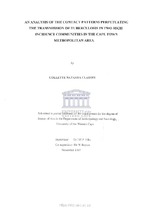| dc.contributor.advisor | Ellis, J.H.P | |
| dc.contributor.author | Classen, Collette Natasha | |
| dc.date.accessioned | 2019-01-28T10:53:31Z | |
| dc.date.available | 2019-01-28T10:53:31Z | |
| dc.date.issued | 1997 | |
| dc.identifier.uri | http://hdl.handle.net/11394/6488 | |
| dc.description | Magister Artium - MA (Anthropology/Sociology) | |
| dc.description.abstract | Biomedicine positively maintains that tuberculosis transmission occurs due to close
contact with a diseased individual (Coovadia and Benatar, 1991). Consequently, this
refers to a direct mode of transmission where individuals are at direct risk of
becoming infected.
It is often taken for granted that when one speaks of contact within the context of
tuberculosis, one is necessarily referring to contact or interactions among tuberculosis
patients and people in the community with whom they have contact of any nature. It
is then assumed that tuberculosis is transmitted in this manner. However, there are
also indirect modes of transmission which are often neglected to be explored, but
have an equally serious effect on transmission in high incidence areas. This paper
also addresses other contact patterns that are also role-players in the tuberculosis
epidemic. | |
| dc.language.iso | en | |
| dc.publisher | University of the Western Cape | |
| dc.subject | Biomedicine | |
| dc.subject | Tuberculosis treatment | |
| dc.subject | Tuberculosis transmission | |
| dc.subject | Cape Town | |
| dc.title | An analysis of the contact patterns perpetuating the transmission of tuberculosis in two high incidence communities in the Cape Town Metropolitan area | |
| dc.rights.holder | University of the Western Cape | |

